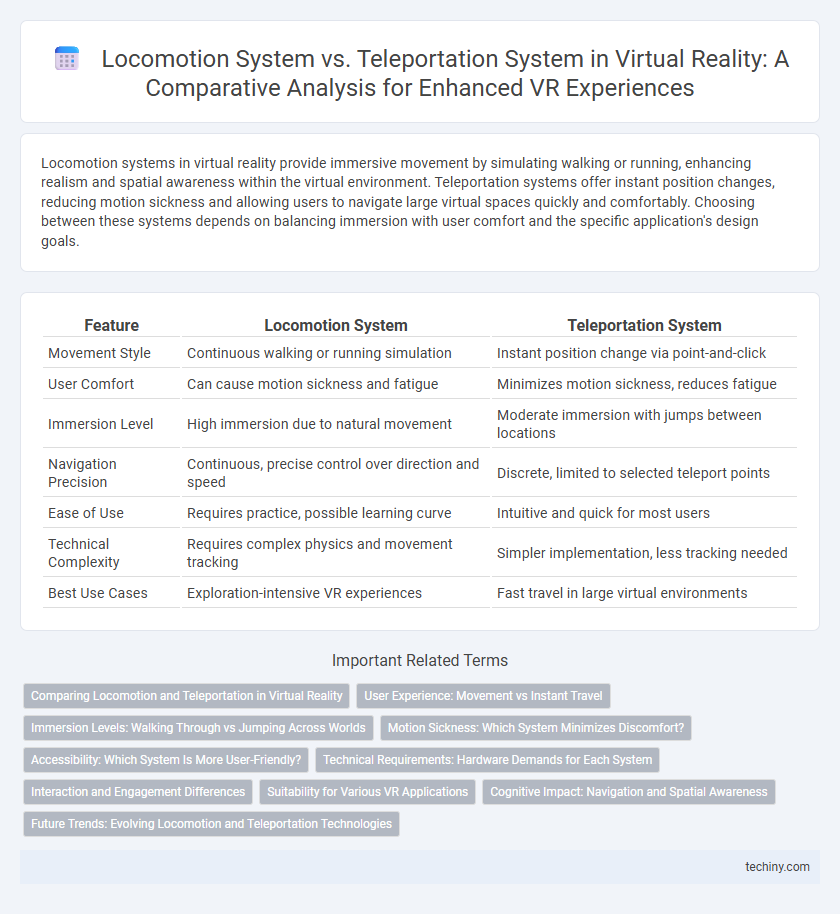Locomotion systems in virtual reality provide immersive movement by simulating walking or running, enhancing realism and spatial awareness within the virtual environment. Teleportation systems offer instant position changes, reducing motion sickness and allowing users to navigate large virtual spaces quickly and comfortably. Choosing between these systems depends on balancing immersion with user comfort and the specific application's design goals.
Table of Comparison
| Feature | Locomotion System | Teleportation System |
|---|---|---|
| Movement Style | Continuous walking or running simulation | Instant position change via point-and-click |
| User Comfort | Can cause motion sickness and fatigue | Minimizes motion sickness, reduces fatigue |
| Immersion Level | High immersion due to natural movement | Moderate immersion with jumps between locations |
| Navigation Precision | Continuous, precise control over direction and speed | Discrete, limited to selected teleport points |
| Ease of Use | Requires practice, possible learning curve | Intuitive and quick for most users |
| Technical Complexity | Requires complex physics and movement tracking | Simpler implementation, less tracking needed |
| Best Use Cases | Exploration-intensive VR experiences | Fast travel in large virtual environments |
Comparing Locomotion and Teleportation in Virtual Reality
Locomotion systems in virtual reality provide continuous movement, enhancing immersion by mimicking real-world navigation, but they often cause motion sickness for some users. Teleportation systems allow instantaneous repositioning within the environment, reducing discomfort and making VR more accessible, though they can break presence due to the discrete jumps. Choosing between locomotion and teleportation depends on the VR application's goals, user comfort, and the desired level of immersion.
User Experience: Movement vs Instant Travel
Locomotion systems in virtual reality emphasize continuous movement, enhancing immersion by replicating natural motion but may cause motion sickness in some users. Teleportation systems offer instant travel to different locations within the virtual environment, reducing discomfort and easing navigation but can disrupt the sense of presence. User experience often balances between the fluidity of locomotion and the comfort and simplicity of teleportation methods.
Immersion Levels: Walking Through vs Jumping Across Worlds
Locomotion systems in virtual reality enhance immersion by allowing users to physically walk through environments, providing natural movement and spatial awareness. Teleportation systems, while reducing motion sickness, often break immersion as users jump abruptly between locations without experiencing continuous movement. High-fidelity VR experiences prioritize locomotion to maintain presence, though teleportation remains popular for fast navigation in expansive virtual worlds.
Motion Sickness: Which System Minimizes Discomfort?
Locomotion systems in virtual reality often induce higher levels of motion sickness due to continuous visual flow mismatching with the user's vestibular system, leading to discomfort and nausea. Teleportation systems minimize motion sickness by instantly relocating the user without simulated movement, reducing sensory conflict and maintaining user comfort during extended sessions. Studies show teleportation significantly decreases the incidence of virtual reality-induced motion sickness compared to traditional locomotion methods.
Accessibility: Which System Is More User-Friendly?
Teleportation systems in virtual reality offer greater accessibility, minimizing motion sickness by instantaneously relocating users without inducing disorientation. Locomotion systems, while providing a more immersive experience, often challenge users with physical fatigue and spatial navigation difficulties, limiting usability for individuals with mobility impairments. User-friendly VR design prioritizes teleportation to ensure comfort and ease of movement across diverse user capabilities.
Technical Requirements: Hardware Demands for Each System
Locomotion systems in virtual reality require advanced motion tracking hardware, including multi-sensor setups and high-performance GPUs to process continuous positional data for realistic user movement. Teleportation systems demand less intensive hardware as they rely on discrete position changes, enabling smoother performance on mid-range processors and simpler tracking mechanisms. Both systems benefit from low-latency sensors and high refresh-rate displays, but locomotion systems impose higher computational and sensor accuracy requirements to minimize motion sickness and latency.
Interaction and Engagement Differences
Locomotion systems in virtual reality offer continuous movement, enhancing user immersion through natural navigation and spatial awareness, which fosters deeper interaction with the environment. Teleportation systems, by contrast, enable instant positional shifts that reduce motion sickness and fatigue but may disrupt spatial continuity, potentially limiting sustained engagement. The choice between locomotion and teleportation directly impacts user experience, balancing realism with comfort to optimize interactive engagement in VR applications.
Suitability for Various VR Applications
Locomotion systems offer continuous movement ideal for exploration and simulation applications requiring spatial awareness, such as virtual training or architectural walkthroughs. Teleportation systems, providing instant repositioning, excel in fast-paced games and scenarios where reducing motion sickness is critical. Choosing between these systems depends on the VR application's need for immersion, user comfort, and interaction complexity.
Cognitive Impact: Navigation and Spatial Awareness
Locomotion systems in virtual reality enhance navigation and spatial awareness by providing continuous movement cues that mimic real-world travel, fostering a more immersive cognitive map of the environment. Teleportation systems, while reducing motion sickness, often disrupt spatial continuity and can impair the user's ability to develop a comprehensive mental representation of virtual spaces. Studies highlight that locomotion supports better memory retention and spatial learning compared to teleportation due to its alignment with natural proprioceptive and vestibular feedback.
Future Trends: Evolving Locomotion and Teleportation Technologies
Future trends in virtual reality emphasize evolving locomotion systems with enhanced haptic feedback, allowing users to experience more natural and immersive movement through advanced sensors and AI-driven motion prediction. Teleportation systems are also progressing with seamless spatial transitions and reduced motion sickness via optimized algorithms and real-time environmental mapping. Integration of hybrid models combining locomotion and teleportation technologies is expected to redefine VR experiences by balancing user comfort and interactive exploration.
Locomotion System vs Teleportation System Infographic

 techiny.com
techiny.com